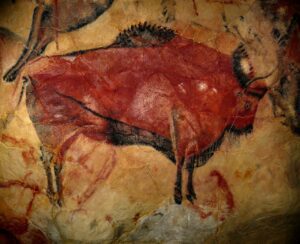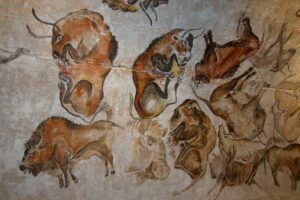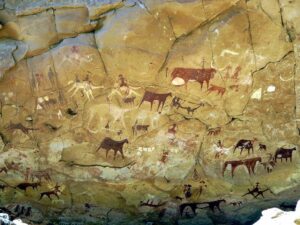Prehistoric art is the earliest form of creative expression known to humanity, predating written history.
It’s a window into the minds of our distant ancestors, revealing their beliefs, experiences, and the world around them.
We’ll explore the various forms of prehistoric art, from cave paintings to ancient sculptures, uncovering the stories they tell about the people who created them.
Join us as we jump into the origins of human creativity and the significance of these ancient masterpieces.
The Origins Of Prehistoric Art
Prehistoric art arises from the very fabric of human existence, dating back to a time when early hominins first discovered the ability to express themselves through visual means.
Reflecting a burgeoning intellectual awakening, the origins of this art form are enmeshed within our ancestors’ need to communicate and understand their world.
Our first artistic endeavors are thought to be simple geometric etchings on shells or stones, whereas later works evolved into more complex representations.
These initial expressions mark a critical juncture in the human cognitive revolution, showcasing our capacity for abstract thought and creativity.
Art historian interpretations suggest prehistoric art served multiple purposes –
- Spiritual or religious rituals,
- Storytelling and historical documentation,
- Social cohesion and communication,
- Artistic expression for its own sake.
Even though the lack of written records, works like the paintings at Lascaux and the sculptures of Venus figurines hint at a rich cultural and symbolic landscape.
These artifacts, steeped in mystery, offer glimpses into the ethos of communities that once thrived across the Earth.
Advancements in dating technologies have propelled our understanding of prehistoric art’s chronology.
It’s been determined that some of the oldest known artworks, like those in Sulawesi, Indonesia, are more than 40,000 years old.
This timeline attests to the deep historical roots art has in shaping our identity and evolution as a species.

Our exploration into the world of prehistoric art is not just an academic pursuit but a quest to uncover the essence of human creativity.
With each discovery, whether it be a new cave painting or intricately carved bone, we inch closer to piecing together the intricate puzzle of our collective past.
Cave Paintings: A Glimpse Into The Past
Cave paintings provide a window into prehistoric life, enabling us to imagine the world through the eyes of our ancestors.
These ancient images, found on the walls and ceilings of caves, were often situated in hard-to-reach places, suggesting they had great significance to the creators.
The techniques employed by these early artists were surprisingly sophisticated, employing natural pigments like ochre, charcoal, and hematite.
They manipulated these materials, using their fingers, brushes made from animal hair, and even blowing pigment through hollow bones to achieve desired effects.
One of the most well-known sites, Lascaux, located in southwestern France, houses a stunning array of prehistoric art.
Dating back to approximately 17,000 years ago, the cave’s extensive collection includes over 600 paintings and 1,500 engravings.
The subjects of cave art vary widely, from mundane depictions of everyday life to profound representations of the mystical and unknown.

Here are some recurring themes we observe:
- Animal figures, such as horses, bison, and mammoths, depicted with remarkable detail,
- Human figures, often shown hunting or participating in rituals,
- Abstract symbols, which may denote ideas, stories, or portray aspects of the natural environment.
Critical analysis of these paintings reveals that prehistoric humans were not just documenting their external world, but also expressing complex thoughts and beliefs.
The images often appear to be in motion, reflecting a dynamic understanding of their subjects.
Advances in technology, including 3D laser scanning and dating methods, have opened new avenues for us to explore these ancient works.
These technological advancements allow us to study the art in greater detail and context, expanding our understanding of the cultural practices of our forebears.
By delving into the enigmatic world of cave paintings, we uncover rich layers of meaning that go beyond mere depiction – revealing the innovation, adaptability, and depth of human expression even in prehistoric times.
Paleolithic Sculptures: Shaping The World
When we reflect on the artistic achievements of our Paleolithic ancestors, our attention often turns to the remarkable sculptures they left behind.
These three-dimensional works were not only crafted with remarkable skill but also carried significant symbolic weight.
Paleolithic sculptures, often small and portable, give us compelling evidence of the early human desire to represent the world around them in various forms.
One of the most iconic Paleolithic sculptures is the Venus of Willendorf.
Believed to date back to around 28,000–25,000 BCE, this small figurine captures our imagination with its exaggerated female features.
Scholars debate its intended use, with theories ranging from fertility idol to a representation of a goddess.
The craftsmanship involved suggests a society with both the time and skill to create meaningful art that stood the test of time.
Beyond the Venus of Willendorf, other notable sculptures include:
- The Lion Man, a figure combining human and animal characteristics, suggesting mythological or religious significance.
- The Bison Licking Insect Bite, showcasing attention to naturalistic detail and movement.
- Bear sculptures from the caves of Montespan, which may have been used in ritual practices.
These sculptures have been discovered in various locations, from the depths of caves to open-air sites, indicating that art was a widespread and integral part of Paleolithic life.
Our understanding of these pieces is enhanced by analyzing their context, the materials used, and the techniques employed by the artists.
By doing so, we uncover rich narratives about the societies that created them and the environments in which they lived.
The diversity in Paleolithic sculpture is a testament to the innovative spirit of our earliest artists.
Not only were they skilled in representing the physical world, but they also ventured into the realms of symbolism and abstraction – challenging the boundaries of what we might expect from prehistoric art.
The sophistication of these works continues to influence our perception of ancient art and humanity’s long-standing engagement with creativity and expression.
Prehistoric Ceramics: Functional And Beautiful
When we jump into the realms of prehistoric art, it’s essential to note that not all art was meant for display.
Prehistoric ceramics signify the progression from merely functional to aesthetically pleasing.
Our ancestors began with simple clay vessels for carrying water and storing grains; soon, they embarked on a journey to adorn these utility objects with complex patterns and designs.
These decorated ceramics are often found at archaeological sites, buried alongside their creators.
The designs etched onto these vessels weren’t just decorative; they held significant cultural relevance.
Our understanding of prehistoric ceramics comes from examining these patterns and the techniques used to create them:
- The coiling method – clay rolled into long strings and coiled to construct the vessel’s shape,
- Pinching techniques – where the clay was shaped and thinned by hands to form delicate pottery,
- Slab construction – using flattened pieces of clay to build the walls of ceramic objects.
The presence of motifs such as spirals, animal figures, and geometric shapes suggests that these items became a canvas for expressing identity and artistic flair.
This progression indicates an awareness of aesthetics and a desire to beautify daily life, a trait that seems inherently human.
While the utility of ceramics is self-evident, it is the journey towards adding beauty to function that truly captivates us.
These early artists transformed mundane objects into works of art, revealing their creative ingenuity.
This creativity denotes the first inklings of a civilization moving towards a culture rich in artistry and craft.
The Symbolism And Meaning Of Prehistoric Art
Unraveling the symbolism and meaning behind prehistoric art is akin to peering through a keyhole into the ancient world.
Each etching, sculpture, or ceramic piece holds a tale – a narrative steeped in the cultural beliefs and practices of early humankind.
We see this not merely as decoration but as a significant mode of communication and representation of their world.
The motifs found in prehistoric artwork often mirror the society’s relationship with nature and the cosmos.

Animal figures in cave paintings, such as those in Lascaux and Chauvet Cave, perhaps served more than a decorative purpose – they may have been part of hunting rituals or totems symbolizing tribal identity.
Similarly, Venus figurines could represent fertility, motherhood, or goddess worship, underscoring a deep reverence for the creation of life.
Challenging as it may be to interpret these ancient symbols with absolute certainty, certain patterns emerge when we examine prehistoric artworks across varied sites:
- Objects or beings depicted repetitively, suggesting their importance in daily life or belief systems,
- Positioning and size of figures hinting at hierarchical structures or significance to the community,
- Use of particular colors or patterns that may correspond to specific qualities or entities known to the people of the time.
These elements within prehistoric art reveal a rich tapestry of meaning, intertwined with the fabric of survival, spirituality, and expression.
Our understanding, though evolving, remains influenced by the ongoing discoveries and interpretations presented by archaeologists and historians.
The excavation of new sites and advancements in technology continue to shed light on the complex relationship between ancient artists and their milieu.
Through these artistic remnants, we glimpse the genesis of cultural narratives and the seeds of human creativity that have flourished throughout the ages.
What Is Prehistoric Art – Wrap Up
We’ve journeyed through the enigmatic world of prehistoric art, uncovering the silent stories etched in stone and molded in clay.
These ancient masterpieces are more than remnants of bygone eras; they’re a testament to the enduring human spirit.
Through cave paintings, sculptures, and ceramics, our ancestors communicated their experiences, beliefs, and identities.
As we reflect on these primordial expressions, we gain invaluable insights into the origins of creativity and the universal language of art that transcends time.
Let’s carry this appreciation forward, recognizing that our own artistic endeavors are part of a continuum that began with the earliest humans who dared to leave their mark.
Frequently Asked Questions
What Is Prehistoric Art?
Prehistoric art refers to the visual creations made by humans in the period before written records existed, mainly characterized by cave paintings, sculptures, and ceramics.
Where Can Prehistoric Art Be Found?
Prehistoric art has been discovered in multiple locations worldwide, predominantly in caves, ancient shelters, and open-air sites.
What Is The Significance Of Cave Paintings?
Cave paintings are significant as they represent some of the earliest forms of human expression and communication, often illustrating the relationship between early humans and their environment.
What Do Paleolithic Sculptures Represent?
Paleolithic sculptures, often carved from stone or bone, typically depict animals and human figures, representing various aspects of life, including fertility, hunting, and spiritual beliefs.
How Do Prehistoric Ceramics Contribute To Our Understanding Of Ancient Cultures?
Prehistoric ceramics provide insight into the daily life, artistic development, and technological advances of ancient societies, as well as their social and ceremonial practices.
What Common Themes Are Found In Prehistoric Art?
Common themes in prehistoric art include the portrayal of animals, human figures, symbols of fertility, and depictions of hunting scenes, reflecting the intimate connection between humans and nature.
How Does Prehistoric Art Reflect Spirituality?
Prehistoric art often includes symbols and motifs that are believed to represent spiritual beliefs and practices, such as shamanism or the worship of natural elements.


